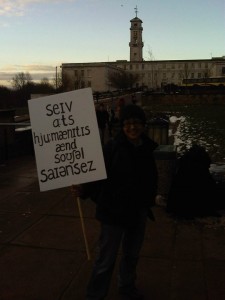One of the questions that came up at the conference was the links between the women’s suffrage movement and protest movements today. There are a couple of points that I think are particularly interesting, although there are bound to be others.
Diversity of the movement
In any large protest movement there are going to be different factions, each with different ideologies, aims, motivations and so on. I’ve seen it first hand in the current anti-cuts movement, particularly within the student movement and even within the group in my university. This isn’t a bad comparison because I think both movements are issues-based and attract people of a huge range of political beliefs.
There are things that unite us but these tend to be quite broad things – general opposition to education and welfare cuts, for example. The things that can be divisive are in the details – what action do we carry out? do we support occupation? is it okay to ally ourselves with trade union groups? communist groups? anarchist collectives? how do we organise ourselves? how do we make decisions? how do we respond to other groups and their campaigns? to whom do we express solidarity? These things are not always simple, and there have been passionate debates about these issues.
The suffrage movement had broad agreement that the franchise should be extended to (some) women, but organisations could differ wildly on the details – should the vote be extended to all women or to women on the same basis as men, with financial and property requirements in place? what should be the role of men? how much independence was needed and/or desirable from political parties? were they happy with contemporary gender norms? what was the vote for – was it a symbolic gesture of women’s equality, or could it be used to improve women’s working conditions, pay and welfare?
Not easy questions, and quite often no right answers.
Direct action and violence
The second point of comparison is what counts as violence, and how individuals and groups within the movement respond to direct action carried out by others in the movement. In my research, one of the things I come across is that violence was carried out against property; this happens today as well. There are numerous accounts of WSPU speakers being verbally and physically abused by men at public meetings and requiring police protection, yet this doesn’t seem to get described as violence. Instead, violence is what happens when suffragette campaigners break windows. I note that Alfie Meadows, the student who had to have emergency brain surgery after being injured in the protests, has been charged with violent disorder (this post discusses it in more detail). Then as now, (some) property seems to be more important than (some) people.
There are also similarities in how those who don’t engage in property damage or other less socially sanctioned methods of direct action respond to those who do. While I was disappointed at the reaction to Millbank, I wasn’t surprised. Those who carried out property damage and so on were said to be attention seekers, their status as “proper” members of the movement challenged, and others in the movement tried to distance themselves as much as possible from the window-breakers. Sound familiar?
I suspect that these issues are ones that any protest movement has to negotiate – they’re not unique to movements. There are points of connection between the suffrage movement and what’s happening today, particularly when it comes to how damage to public property and injury to protesters are discussed, and it’s these points of connection that think are interesting.
In happier news, my favourite bookshop turns 37 this weekend – happy birthday News from Nowhere! Here’s some of their history for the interested.

